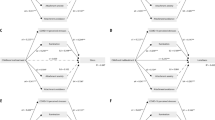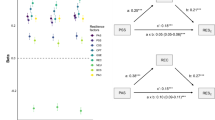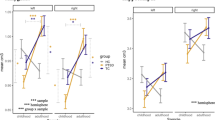Abstract
The human toll of disasters extends beyond death, injury and loss. Post-traumatic stress (PTS) can be common among directly exposed individuals, and children are particularly vulnerable. Even children far removed from harm’s way report PTS, and media-based exposure may partially account for this phenomenon. In this study, we examine this issue using data from nearly 400 9- to 11-year-old children collected before and after Hurricane Irma, evaluating whether pre-existing neural patterns moderate associations between hurricane experiences and later PTS. The ‘dose’ of both self-reported objective exposure and media exposure predicted PTS, the latter even among children far from the hurricane. Furthermore, neural responses in brain regions associated with anxiety and stress conferred particular vulnerability. For example, heightened amygdala reactivity to fearful stimuli moderated the association between self-reported media exposure and PTS. Collectively, these findings show that for some youth with measurable vulnerability, consuming extensive disaster-related media may offer an alternative pathway to disaster exposure that transcends geography and objective risk.
This is a preview of subscription content, access via your institution
Access options
Access Nature and 54 other Nature Portfolio journals
Get Nature+, our best-value online-access subscription
$29.99 / 30 days
cancel any time
Subscribe to this journal
Receive 12 digital issues and online access to articles
$119.00 per year
only $9.92 per issue
Buy this article
- Purchase on Springer Link
- Instant access to full article PDF
Prices may be subject to local taxes which are calculated during checkout





Similar content being viewed by others
Data availability
The ABCD data repository grows and changes over time. The ABCD data used in this report, including the substudy data collected outside of the baseline visits, came from RDS Fix Release 2.0.1 (https://doi.org/10.15154/1504431) and from the minimally processed imaging data available through abcd-sync. The data are available by request from the NIMH Data Archive (https://data-archive.nimh.nih.gov/abcd).
Code availability
All software used in the present analysis is open source. The R code (CRAN; v.3.6.0) to replicate the analysis is available at https://github.com/anthonystevendick/irmasubstudy_abcd.
References
World Disasters Report 2018: Leaving No One Behind (International Federation of Red Cross and Red Crescent Societies, 2018).
Cai, W. et al. Increasing frequency of extreme El Niño events due to greenhouse warming. Nat. Clim. Change 4, 111–116 (2014).
Kessler, R. C. et al. Trends in mental illness and suicidality after Hurricane Katrina. Mol. Psychiatry 13, 374–384 (2008).
North, C. S. & Pfefferbaum, B. Mental health response to community disasters: a systematic review. JAMA 310, 507–518 (2013).
Orengo-Aguayo, R., Stewart, R. W., de Arellano, M. A., Suarez-Kindy, J. L. & Young, J. Disaster exposure and mental health among Puerto Rican youths after Hurricane Maria. JAMA Netw. Open 2, e192619 (2019).
Furr, J. M., Comer, J. S., Edmunds, J. M. & Kendall, P. C. Disasters and youth: a meta-analytic examination of posttraumatic stress. J. Consult. Clin. Psychol. 78, 765–780 (2010).
Goldmann, E. & Galea, S. Mental health consequences of disasters. Annu. Rev. Public Health 35, 169–183 (2014).
Pfefferbaum, B. et al. Posttraumatic stress two years after the Oklahoma City bombing in youths geographically distant from the explosion. Psychiatry 63, 358–370 (2000).
Schuster, M. A. et al. A national survey of stress reactions after the September 11, 2001, terrorist attacks. N. Engl. J. Med. 345, 1507–1512 (2001).
Suvak, M., Maguen, S., Litz, B. T., Silver, R. C. & Holman, E. A. Indirect exposure to the September 11 terrorist attacks: does symptom structure resemble PTSD? J. Trauma. Stress 21, 30–39 (2008).
Comer, J. S. et al. Adjustment among area youth after the Boston Marathon bombing and subsequent manhunt. Pediatrics 134, 7–14 (2014).
Holman, E. A., Garfin, D. R. & Silver, R. C. Media’s role in broadcasting acute stress following the Boston Marathon bombings. Proc. Natl Acad. Sci. USA 111, 93–98 (2014).
Thompson, R. R., Jones, N. M., Holman, E. A. & Silver, R. C. Media exposure to mass violence events can fuel a cycle of distress. Sci. Adv. 5, eaav3502 (2019).
Vasterman, P., Yzermans, C. J. & Dirkzwager, A. J. The role of the media and media hypes in the aftermath of disasters. Epidemiol. Rev. 27, 107–114 (2005).
Thompson, R. R., Holman, E. A. & Silver, R. C. Media coverage, forecasted posttraumatic stress symptoms, and psychological responses before and after an approaching hurricane. JAMA Netw. Open 2, e186228 (2019).
Wong, S. D., Pel, A. J., Shaheen, S. A. & Chorus, C. G. Fleeing from Hurricane Irma: empirical analysis of evacuation behavior using discrete choice theory. Transp. Res. 79, 102227 (2020).
Comer, J. S. & Kendall, P. C. Terrorism: the psychological impact on youth. Clin. Psychol. 14, 179–212 (2007).
Comer, J. S., D’eSerisy, M. & Green, J. G. Caregiver-reports of Internet exposure and posttraumatic stress among Boston-area youth following the 2013 marathon bombing. Evid. Based Pract. Child Adolesc. Ment. Health 1, 86–102 (2016).
Busso, D. S., McLaughlin, K. A. & Sheridan, M. A. Media exposure and sympathetic nervous system reactivity predict PTSD symptoms after the Boston Marathon bombings. Depress. Anxiety 31, 551–558 (2014).
Robinson, O. J., Pike, A. C., Cornwell, B. & Grillon, C. The translational neural circuitry of anxiety. J. Neurol. Neurosurg. Psychiatry https://doi.org/10.1136/jnnp-2019-321400 (2019).
LeDoux, J. E. & Pine, D. S. Using neuroscience to help understand fear and anxiety: a two-system framework. Am. J. Psychiatry 173, 1083–1093 (2016).
Shin, L. M. & Liberzon, I. The neurocircuitry of fear, stress, and anxiety disorders. Neuropsychopharmacology 35, 169–191 (2010).
Tovote, P., Fadok, J. P. & Luthi, A. Neuronal circuits for fear and anxiety. Nat. Rev. Neurosci. 16, 317–331 (2015).
Casey, B. J. et al. The Adolescent Brain Cognitive Development (ABCD) Study: imaging acquisition across 21 sites. Dev. Cogn. Neurosci. 32, 43–54 (2018).
Swartz, J. R., Knodt, A. R., Radtke, S. R. & Hariri, A. R. A neural biomarker of psychological vulnerability to future life stress. Neuron 85, 505–511 (2015).
Hiser, J. & Koenigs, M. The multifaceted role of the ventromedial prefrontal cortex in emotion, decision making, social cognition, and psychopathology. Biol. Psychiatry 83, 638–647 (2018).
Etkin, A. & Wager, T. D. Functional neuroimaging of anxiety: a meta-analysis of emotional processing in PTSD, social anxiety disorder, and specific phobia. Am. J. Psychiatry 164, 1476–1478 (2007).
Thome, J., Terpou, B. A., McKinnon, M. C. & Lanius, R. A. The neural correlates of trauma-related autobiographical memory in posttraumatic stress disorder: a meta-analysis. Depress. Anxiety 37, 321–345 (2020).
Stevens, J. S. et al. Disrupted amygdala–prefrontal functional connectivity in civilian women with posttraumatic stress disorder. J. Psychiatr. Res. 47, 1469–1478 (2013).
Mattson, W. I., Hyde, L. W., Shaw, D. S., Forbes, E. E. & Monk, C. S. Clinical neuroprediction: amygdala reactivity predicts depressive symptoms 2 years later. Soc. Cogn. Affect. Neurosci. 11, 892–898 (2016).
Bryant, R. A. et al. Enhanced amygdala and medial prefrontal activation during nonconscious processing of fear in posttraumatic stress disorder: an fMRI study. Hum. Brain Mapp. 29, 517–523 (2008).
Killgore, W. D. et al. Cortico-limbic responses to masked affective faces across PTSD, panic disorder, and specific phobia. Depress. Anxiety 31, 150–159 (2014).
Bijanki, K. R. et al. Case series: unilateral amygdala ablation ameliorates post-traumatic stress disorder symptoms and biomarkers. Neurosurgery https://doi.org/10.1093/neuros/nyaa051 (2020).
McLaughlin, K. A. et al. Amygdala response to negative stimuli predicts PTSD symptom onset following a terrorist attack. Depress. Anxiety 31, 834–842 (2014).
Stevens, J. S. et al. Amygdala reactivity and anterior cingulate habituation predict posttraumatic stress disorder symptom maintenance after acute civilian trauma. Biol. Psychiatry 81, 1023–1029 (2017).
Milad, M. R. et al. Neurobiological basis of failure to recall extinction memory in posttraumatic stress disorder. Biol. Psychiatry 66, 1075–1082 (2009).
Jovanovic, T. et al. Reduced neural activation during an inhibition task is associated with impaired fear inhibition in a traumatized civilian sample. Cortex 49, 1884–1891 (2013).
Shin, L. M. et al. A functional magnetic resonance imaging study of amygdala and medial prefrontal cortex responses to overtly presented fearful faces in posttraumatic stress disorder. Arch. Gen. Psychiatry 62, 273–281 (2005).
Sripada, R. K. et al. Altered resting-state amygdala functional connectivity in men with posttraumatic stress disorder. J. Psychiatry Neurosci. 37, 241–249 (2012).
Koenigs, M. & Grafman, J. Posttraumatic stress disorder: the role of medial prefrontal cortex and amygdala. Neuroscientist 15, 540–548 (2009).
Admon, R., Milad, M. R. & Hendler, T. A causal model of post-traumatic stress disorder: disentangling predisposed from acquired neural abnormalities. Trends Cogn. Sci. 17, 337–347 (2013).
Sakamoto, H. et al. Parahippocampal activation evoked by masked traumatic images in posttraumatic stress disorder: a functional MRI study. Neuroimage 26, 813–821 (2005).
Shin, L. M. et al. Hippocampal function in posttraumatic stress disorder. Hippocampus 14, 292–300 (2004).
Aminoff, E. M., Kveraga, K. & Bar, M. The role of the parahippocampal cortex in cognition. Trends Cogn. Sci. 17, 379–390 (2013).
Maroun, M. Stress reverses plasticity in the pathway projecting from the ventromedial prefrontal cortex to the basolateral amygdala. Eur. J. Neurosci. 24, 2917–2922 (2006).
Kessel, E. M. et al. Hurricane Sandy exposure alters the development of neural reactivity to negative stimuli in children. Child Dev. 89, 339–348 (2018).
Kujawa, A. et al. Neural reactivity to emotional stimuli prospectively predicts the impact of a natural disaster on psychiatric symptoms in children. Biol. Psychiatry 80, 381–389 (2016).
Swartz, J. R., Williamson, D. E. & Hariri, A. R. Developmental change in amygdala reactivity during adolescence: effects of family history of depression and stressful life events. Am. J. Psychiatry 172, 276–283 (2015).
Parry, D. A. et al. A systematic review and meta-analysis of discrepancies between logged and self-reported digital media use. Nat. Hum. Behav. https://doi.org/10.1038/s41562-021-01117-5 (2021).
Funder, D. C. & Ozer, D. J. Evaluating effect size in psychological research: sense and nonsense. Adv. Methods Pract. Psychol. Sci. 2, 156–168 (2019).
Dick, A. S. et al. Meaningful associations in the adolescent brain cognitive development study. NeuroImage 239, 118262 (2021).
Abelson, R. P. A variance explanation paradox: when a little is a lot. Psychol. Bull. 97, 129–133 (1985).
Kavanagh, J. et al. News in a Digital Age: Comparing the Presentation of News Information over Time and Across Media Platforms (RAND Corporation, 2019).
Garavan, H. et al. Recruiting the ABCD sample: design considerations and procedures. Dev. Cogn. Neurosci. https://doi.org/10.1016/j.dcn.2018.04.004 (2018).
Barch, D. M. et al. Demographic, physical and mental health assessments in the Adolescent Brain and Cognitive Development Study: rationale and description. Dev. Cogn. Neurosci. https://doi.org/10.1016/j.dcn.2017.10.010 (2017).
R Core Team. R: A Language And Environment For Statistical Computing (R Foundation for Statistical Computing, 2021).
Lai, B. S., Lewis, R., Livings, M. S., La Greca, A. M. & Esnard, A. M. Posttraumatic stress symptom trajectories among children after disaster exposure: a review. J. Trauma. Stress 30, 571–582 (2017).
Green, B. L. & Lindy, J. D. Post-traumatic stress disorder in victims of disasters. Psychiatr. Clin. North Am. 17, 301–309 (1994).
Achenbach, T. M. & Rescorla, L. Manual for the ASEBA School-Age Forms & Profiles: An Integrated System of Multi-informant Assessment (ASEBA, 2001).
Delahanty, D. L. & Nugent, N. R. Predicting PTSD prospectively based on prior trauma history and immediate biological responses. Ann. N. Y. Acad. Sci. 1071, 27–40 (2006).
Bonanno, G. A., Brewin, C. R., Kaniasty, K. & Greca, A. M. Weighing the costs of disaster: consequences, risks, and resilience in individuals, families, and communities. Psychol. Sci. Public Interest 11, 1–49 (2010).
Barch, D. M. et al. Function in the human connectome: task-fMRI and individual differences in behavior. Neuroimage 80, 169–189 (2013).
Hare, T. A. et al. Biological substrates of emotional reactivity and regulation in adolescence during an emotional go–nogo task. Biol. Psychiatry 63, 927–934 (2008).
Tottenham, N. et al. The NimStim Set of Facial Expressions: judgments from untrained research participants. Psychiatry Res. 168, 242–249 (2009).
Conley, M. I. et al. The racially diverse affective expression (RADIATE) face stimulus set. Psychiatry Res. 270, 1059–1067 (2018).
Hagler, D. J. et al. Image processing and analysis methods for the Adolescent Brain Cognitive Development Study. Neuroimage 202, 116091 (2019).
Dosenbach, N. U. F. et al. Real-time motion analytics during brain MRI improve data quality and reduce costs. Neuroimage 161, 80–93 (2017).
Robinson, O. J. et al. Towards a mechanistic understanding of pathological anxiety: the dorsal medial prefrontal–amygdala ‘aversive amplification’ circuit in unmedicated generalized and social anxiety disorders. Lancet Psychiatry 1, 294–302 (2014).
Heller, A. S. in Post-traumatic Stress Disorder (eds Nemeroff, C. B. & Marmar, C.) 315–330 (Oxford Univ. Press, 2018).
Destrieux, C., Fischl, B., Dale, A. & Halgren, E. Automatic parcellation of human cortical gyri and sulci using standard anatomical nomenclature. Neuroimage 53, 1–15 (2010).
Cox, R. W., Chen, G., Glen, D. R., Reynolds, R. C. & Taylor, P. A. fMRI clustering in AFNI: false-positive rates redux. Brain Connect. 7, 152–171 (2017).
La Greca, A. M., Silverman, W. K., Lai, B. & Jaccard, J. Hurricane-related exposure experiences and stressors, other life events, and social support: concurrent and prospective impact on children’s persistent posttraumatic stress symptoms. J. Consult. Clin. Psychol. 78, 794–805 (2010).
Vernberg, E. M., Silverman, W. K., La Greca, A. M. & Prinstein, M. J. Prediction of posttraumatic stress symptoms in children after Hurricane Andrew. J. Abnorm. Psychol. 105, 237–248 (1996).
Carpenter, A. L. et al. Event-related household discussions following the Boston Marathon bombing and associated posttraumatic stress among area youth. J. Clin. Child Adolesc. Psychol. 46, 331–342 (2017).
La Greca, A. M. et al. Before the storm: stressors associated with the Hurricane Irma evacuation process for families. Disaster Med. Public Health Prep. 13, 63–73 (2019).
Steinberg, A. M., Brymer, M. J., Decker, K. B. & Pynoos, R. S. The University of California at Los Angeles Post-traumatic Stress Disorder Reaction Index. Curr. Psychiatry Rep. 6, 96–100 (2004).
Steinberg, A. M. et al. Psychometric properties of the UCLA PTSD Reaction Index: part I. J. Trauma. Stress 26, 1–9 (2013).
Elhai, J. D. et al. Psychometric properties of the UCLA PTSD Reaction Index. Part II: investigating factor structure findings in a national clinic-referred youth sample. J. Trauma. Stress 26, 10–18 (2013).
Wilcox, R. R. Introduction to Robust Estimation and Hypothesis Testing 3rd edn (Academic Press, 2012).
Benjamini, Y. & Hochberg, Y. Controlling the false discovery rate: a practical and powerful approach to multiple testing. J. R. Stat. Soc. B 57, 289–300 (1995).
Cohen, J. Statistical Power Analysis for the Behavioral Sciences 2nd edn (Erlbaum, 1988).
Acknowledgements
We thank the families and children who participated and continue to participate in the ABCD Study, as well as staff at the study sites, Data Analysis and Informatics Core, and site personnel involved in data collection and curating the data release. The data used in the preparation of this article were obtained from the ABCD Study (https://abcdstudy.org), held in the NIMH Data Archive. This is a multisite, longitudinal study designed to recruit more than 10,000 children ages 9–10 and follow them over 10 years into early adulthood. The ABCD Study is supported by the National Institutes of Health and additional federal partners under award numbers U01DA041048, U01DA050989, U01DA051016, U01DA041022, U01DA051018, U01DA051037, U01DA050987, U01DA041174, U01DA041106, U01DA041117, U01DA041028, U01DA041134, U01DA050988, U01DA051039, U01DA041156, U01DA041025, U01DA041120, U01DA051038, U01DA041148, U01DA041093, U01DA041089, U24DA041123 and U24DA041147 and National Science Foundation RAPID award number 1805645 to A.S.D. and J.S.C. A full list of supporters is available at https://abcdstudy.org/federal-partners.html. A list of participating sites and a complete list of the study investigators can be found at https://abcdstudy.org/consortium_members/. ABCD consortium investigators designed and implemented the study and/or provided data but did not necessarily participate in the analysis or writing of this report. This manuscript reflects the views of the authors and may not reflect the opinions or views of the National Institutes of Health or ABCD consortium investigators. The funders had no role in study design, data collection and analysis, decision to publish or preparation of the manuscript.
Author information
Authors and Affiliations
Contributions
All authors contributed to the conception of the study and/or the collection and curation of the data. A.S.D. and W.K.T. analysed the data. A.S.D. and J.S.C. wrote the draft manuscript. K.S., R.G., M.T.S., A.R.L., W.K.T., S.F.T., L.M.S., K.M.G., S.J.N., L.B.C., A.M.L.G. and R.H.G. reviewed and commented on the draft for the final write-up of the study. All authors reviewed and approved the manuscript.
Corresponding author
Ethics declarations
Competing interests
The authors declare no competing interests.
Additional information
Peer review information Nature Human Behaviour thanks Jennifer Stevens and the other, anonymous, reviewer(s) for their contribution to the peer review of this work. Peer reviewer reports are available.
Publisher’s note Springer Nature remains neutral with regard to jurisdictional claims in published maps and institutional affiliations.
Supplementary information
Rights and permissions
About this article
Cite this article
Dick, A.S., Silva, K., Gonzalez, R. et al. Neural vulnerability and hurricane-related media are associated with post-traumatic stress in youth. Nat Hum Behav 5, 1578–1589 (2021). https://doi.org/10.1038/s41562-021-01216-3
Received:
Accepted:
Published:
Issue Date:
DOI: https://doi.org/10.1038/s41562-021-01216-3
This article is cited by
-
Children’s Expressions of Gratitude for General and Specific Categories Amid a Pandemic
Journal of Happiness Studies (2024)
-
Increased adolescent game usage and health-related risk behaviors during the COVID-19 pandemic
Current Psychology (2023)
-
The Impact of COVID-19 Experiences on Adolescent Internalizing Problems and Substance Use Among a Predominantly Latinx Sample
Journal of Youth and Adolescence (2022)
-
Trauma, media and the brain
Nature Human Behaviour (2021)



